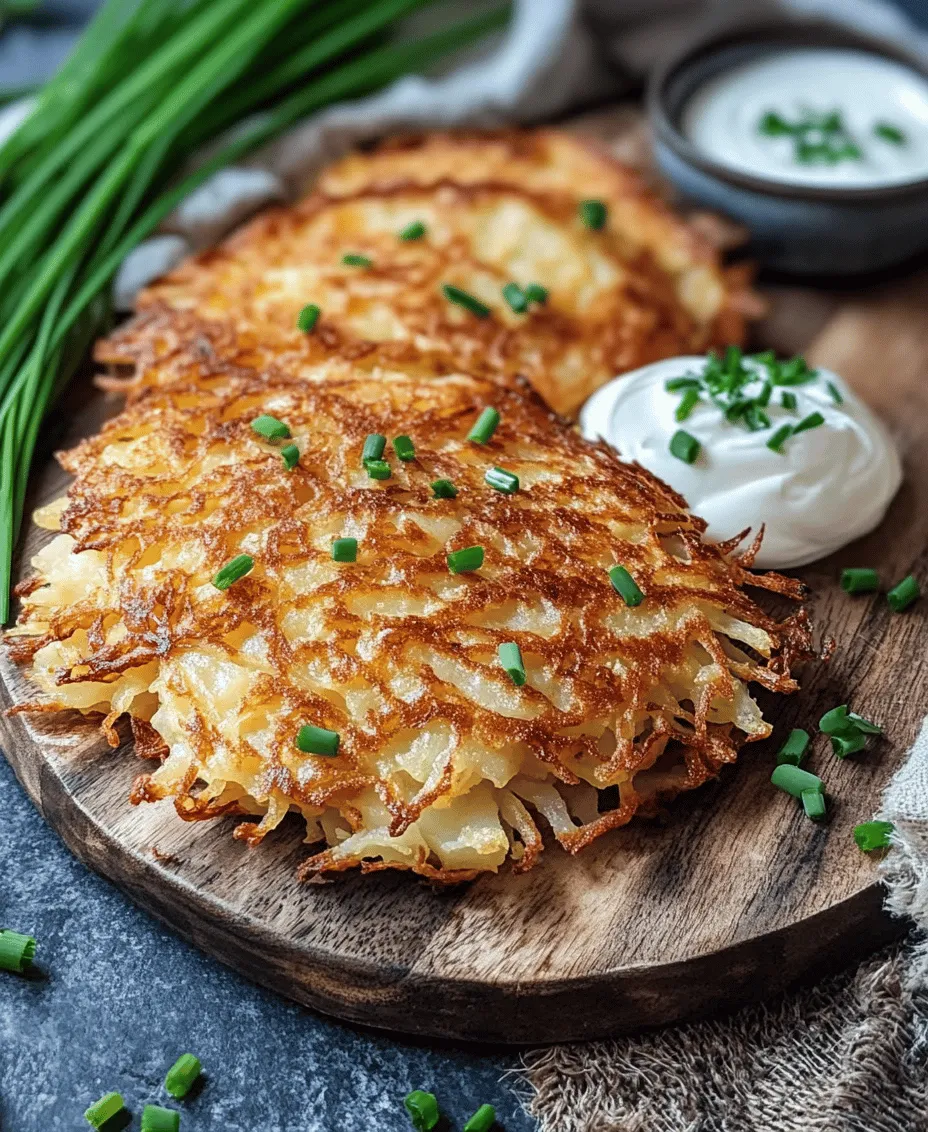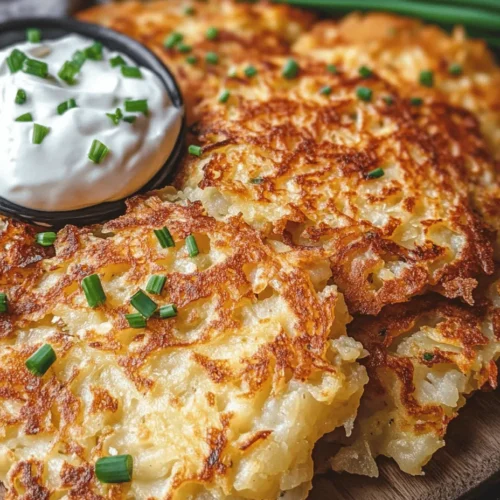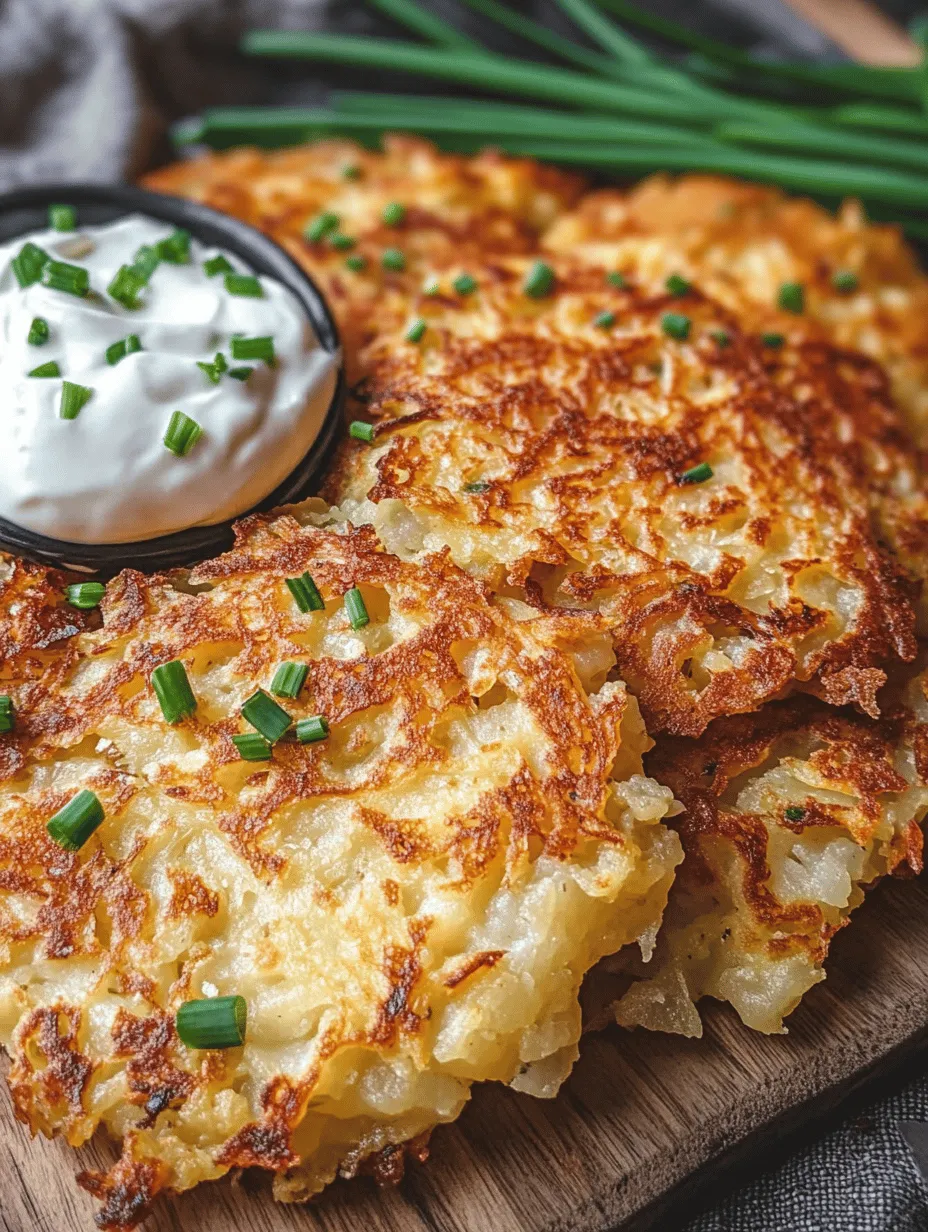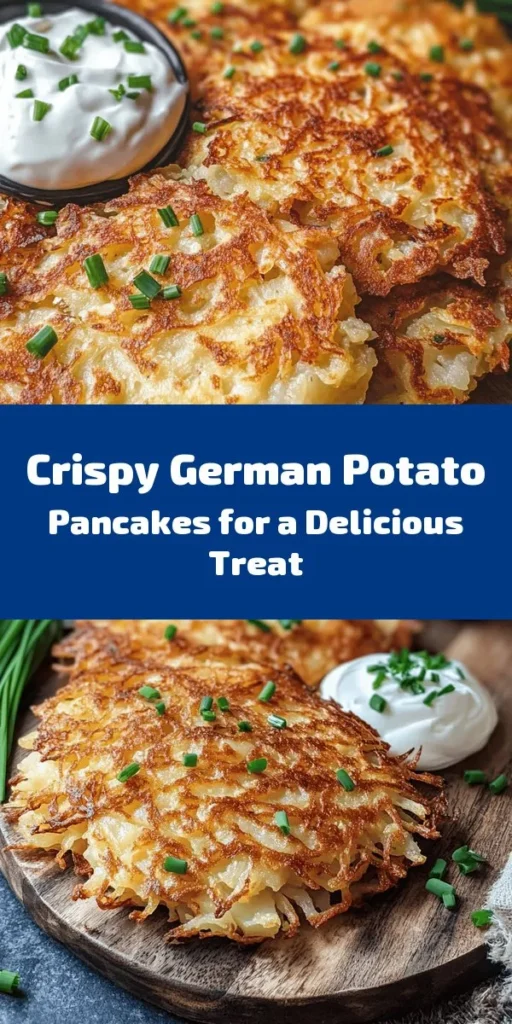Introduction to Crispy German Potato Pancakes
Crispy German potato pancakes, or Kartoffelpuffer, are a beloved staple in German cuisine, cherished for their delightful crunch and comforting flavors. These golden-brown pancakes are more than just a dish; they are a cultural emblem, enjoyed by families during festive gatherings and as a satisfying everyday meal. With a harmonious blend of simple ingredients, Kartoffelpuffer embodies the essence of rustic cooking, where quality overcomes complexity.
As we dive into this recipe, we will not only explore the delectable steps involved in creating these crispy delights but also uncover the rich historical tapestry that has woven this dish into the fabric of German culinary tradition. From the origins of the Kartoffelpuffer to the essential ingredients that create its authentic flavor, we’ll provide you with everything you need to master this comforting classic.
Understanding the Origins of German Potato Pancakes
The Cultural Significance of Kartoffelpuffer
Potato pancakes have a longstanding presence in German culture, dating back centuries. The humble potato, introduced to Europe in the late 16th century, quickly became a staple food, particularly in Germany. Kartoffelpuffer emerged as a practical solution to utilize this versatile ingredient, transforming it into a beloved dish that could be enjoyed by families of all backgrounds.
Traditionally, these pancakes were associated with harvest time, serving as a hearty meal for farmers and laborers. They were often made during festivals, particularly during the autumn months when potatoes were freshly harvested. The aroma of frying potato pancakes wafting through the air became a signature of local fairs and street markets. Today, Kartoffelpuffer remains a popular choice during festive periods, especially during Christmas markets, where they are often served hot with a side of applesauce or sour cream.
The Evolution of Ingredients
As with many traditional dishes, the recipe for Kartoffelpuffer has evolved over time. Originally made with just potatoes and salt, various regions in Germany began to incorporate different ingredients to enhance flavor and texture. In the northern parts of Germany, for example, it is common to add finely grated onions, while southern variations may include a touch of flour or eggs to bind the mixture.
The adaptability of the recipe reflects regional tastes and available ingredients, showcasing the creativity of home cooks who have passed down their family traditions. Today, while the basic recipe remains the same, modern cooks have the freedom to experiment with ingredients, adding herbs, spices, or even different types of potatoes to create unique variations on this classic dish.
Ingredients Breakdown
Essential Ingredients for Authentic Flavor
To recreate the authentic flavor of crispy German potato pancakes, it’s essential to use high-quality ingredients. Here’s a breakdown of the key components:
– Russet Potatoes: These starchy potatoes are ideal for making Kartoffelpuffer due to their high starch content, which helps achieve the perfect crispy texture. When selecting potatoes, opt for firm, blemish-free specimens for the best results.
– Onion: The inclusion of onion in the batter is crucial for adding moisture and flavor. A finely grated onion can enhance the overall taste of the pancakes and provides a subtle sweetness that balances the earthiness of the potatoes.
– Eggs: While traditional recipes may omit eggs, they can help bind the ingredients together and add richness to the pancakes. If you prefer a vegan version, you can substitute with a flaxseed egg or simply omit the egg altogether.
– Flour: A small amount of all-purpose flour can be added to help absorb excess moisture and improve the structure of the pancakes. Be cautious not to add too much, as this can weigh down the batter.
– Salt and Pepper: Simple seasoning is key. A generous pinch of salt enhances the natural flavors of the potatoes and onions, while freshly ground black pepper adds a touch of warmth.
Optional Garnishes and Accompaniments
While Kartoffelpuffer can be enjoyed on their own, adding garnishes and accompaniments can elevate the dish even further. Here are some popular options:
– Fresh Herbs: Chopped chives or parsley can add a pop of color and freshness to your potato pancakes. Sprinkle them on top just before serving for an appealing presentation.
– Applesauce: This classic pairing adds a sweet and tangy contrast to the savory pancakes. The smooth texture of applesauce complements the crispy exterior, making for a delightful bite.
– Sour Cream: A dollop of sour cream on top of your Kartoffelpuffer enhances the flavor and adds a creamy richness that balances the crispy texture.
– Smoked Salmon: For a sophisticated twist, consider serving your potato pancakes with slices of smoked salmon and a sprinkle of capers. This combination adds a gourmet touch to the dish.
Step-by-Step Preparation Guide
Creating the ultimate crispy German potato pancakes requires a bit of technique, particularly when it comes to preparing the potatoes and mixing the batter. Follow these steps for optimal results.
Preparing the Potatoes for Optimal Crispiness
1. Peeling: Start by peeling the Russet potatoes. Using a vegetable peeler, carefully remove the skin to expose the starchy flesh underneath. This step is essential as the skin can impart a bitter taste and affect the overall texture of the pancakes.
2. Grating: Once peeled, it’s time to grate the potatoes. Use a box grater or a food processor fitted with a grating attachment for efficiency. Aim for a fine to medium grate; the smaller pieces will cook more evenly and contribute to a crispier pancake.
3. Removing Excess Moisture: This is one of the most critical steps in achieving crispy Kartoffelpuffer. After grating, transfer the potato shreds to a clean kitchen towel or cheesecloth. Gather the edges of the cloth and twist to squeeze out as much moisture as possible. This process helps prevent the pancakes from becoming soggy during cooking.
Grating the Onion for Enhanced Flavor
1. Selecting the Onion: Choose a medium-sized onion, yellow or white, for a balanced flavor. If you prefer a milder taste, a sweet onion can also work well.
2. Grating Technique: Using the same grater or food processor, finely grate the onion. This will release its juices, which will blend seamlessly with the potato mixture, adding moisture and flavor.
3. Mixing with Potatoes: Once grated, combine the onion with the prepared potato shreds in a large mixing bowl. The moisture from the onion will help bind the ingredients together and enhance the overall flavor profile of the pancakes.
Mixing the Perfect Batter
1. Combining Ingredients: In the bowl containing the grated potatoes and onion, add the eggs (if using), flour, salt, and pepper. Gently fold the ingredients together until just combined. Be careful not to overmix, as this can lead to a denser texture.
2. Adjusting Consistency: The batter should be thick enough to hold its shape but not overly dry. If it’s too wet, add a little more flour until you reach the desired consistency. If you’ve opted for a vegan version, ensure that your mixture is cohesive enough to form patties.
As you prepare the batter, envision the final product: crispy, golden-brown pancakes that will transport you to a cozy German kitchen with each bite. In the upcoming sections, we’ll continue with the frying process, cooking tips, and serving suggestions that will take your Kartoffelpuffer to the next level. Stay tuned as we explore the exciting world of crispy German potato pancakes!

Mixing the Ingredients: Achieving the Right Consistency
To begin making your crispy German potato pancakes, start by mixing your ingredients thoroughly. After grating your potatoes, place them in a bowl and prepare to add the remaining components. The balance of ingredients is crucial; you want to achieve a batter that holds together well but isn’t too dense. Here’s how to get it just right:
1. Combine the Grated Potatoes and Onion: In a large mixing bowl, combine the grated potatoes with finely grated onion. The onion not only enhances the flavor but also contributes moisture, which is essential for the consistency of your batter.
2. Add the Eggs and Flour: Crack two large eggs into the mixture, followed by around ¼ cup of all-purpose flour. The eggs act as a binding agent, while the flour helps absorb excess moisture. For a gluten-free alternative, consider using an equal amount of almond flour or a gluten-free all-purpose blend.
3. Season Generously: Don’t forget to season your batter with salt and pepper. About 1 teaspoon of salt and ½ teaspoon of black pepper should suffice, but adjust according to your taste preferences. For added flavor, consider incorporating dried herbs like thyme or dill.
4. Check the Consistency: The mixture should be thick enough to hold its shape but still loose enough to spread slightly when ladled into the hot oil. If the batter seems too wet, add a little more flour; if it looks too dry, you can add a tablespoon of water.
Cooking Techniques for Perfect Pancakes
Heating the Oil: The Key to Crispiness
The secret to achieving that delightful crispy exterior lies in the temperature of your oil. Using the right oil is also essential; vegetable oil or canola oil works well due to their high smoke points.
1. Choosing Your Oil: About ½ inch of oil in a large skillet or frying pan is ideal for frying. Ensure you have sufficient oil to submerge the bottom of the pancakes without allowing them to stick.
2. Testing the Oil Temperature: To test if your oil is ready, drop a small amount of the batter into the pan. If it sizzles immediately and rises to the surface, the oil is at the perfect frying temperature (around 350°F or 175°C). If it browns too quickly or burns, reduce the heat slightly.
Shaping and Frying the Pancakes
Once your oil is hot, it’s time to shape and fry your pancakes.
1. Forming the Pancakes: Using a large spoon or an ice cream scoop, take a portion of the batter and gently drop it into the hot oil. Using the back of the spoon, flatten the batter into a disc shape, about ½ inch thick. Be careful not to overcrowd the pan; you want space for each pancake to fry evenly.
2. Cooking Time: Allow each pancake to fry undisturbed for about 3 to 4 minutes on the first side. When the edges start to turn golden brown, carefully flip the pancake using a spatula. Fry the other side for an additional 3 to 4 minutes until it is equally golden brown.
3. Monitoring Heat: If necessary, adjust the heat during cooking to avoid burning. If the oil starts to smoke, it’s too hot; reduce the heat and allow it to cool slightly before continuing.
Draining Excess Oil: A Step for Healthier Pancakes
After frying, it’s essential to drain the excess oil from your pancakes.
1. Using a Paper Towel: Place the cooked pancakes on a plate lined with paper towels. This step is crucial as it absorbs the excess oil, leaving you with a lighter, less greasy pancake.
2. Keep Warm: If you’re cooking multiple batches, place the drained pancakes on a baking sheet in a warm oven (around 200°F or 93°C) to keep them warm while you fry the rest.
Serving Suggestions and Pairings
Your crispy German potato pancakes are now ready to be served! Here are some delightful serving suggestions and creative variations to consider.
Best Ways to Serve Crispy German Potato Pancakes
1. Traditional Toppings: The classic accompaniments for potato pancakes are applesauce and sour cream. The sweetness of the applesauce balances the savory flavors, while the sour cream adds a creamy texture.
2. Fresh Herbs: Garnish with freshly chopped chives or parsley for a pop of color and flavor. These herbs can also provide a fresh contrast to the richness of the pancakes.
3. Smoked Salmon or Bacon: For a luxurious twist, serve the pancakes topped with smoked salmon or crispy bacon. The smoky flavors enhance the dish, making it perfect for brunch or special occasions.
4. Vegetarian Options: Consider pairing your pancakes with a fresh salad or sautéed mushrooms for a vegetarian-friendly meal. The earthiness of mushrooms complements the potatoes beautifully.
Creative Variations to Try
1. Herb-Infused Batter: Experiment by mixing in fresh herbs like dill, thyme, or chives into your batter for additional flavor.
2. Spiced Variations: For a unique flavor profile, mix in spices such as garlic powder, paprika, or even a pinch of cayenne pepper for heat.
3. Sweet Potato Pancakes: Substitute half of the potatoes with sweet potatoes for a sweeter version of this dish. This variation adds a beautiful color and a distinct taste.
4. Cheese Lovers: Incorporate shredded cheese into the batter—like cheddar or feta—before frying for a cheesy twist that adds richness.
Nutritional Information
Understanding the nutritional impact of crispy German potato pancakes can help you enjoy them as part of a balanced diet. Here’s a breakdown of the nutritional values per serving (approximately two pancakes):
– Calories: 200
– Total Fat: 12g
– Saturated Fat: 2g
– Cholesterol: 55mg
– Sodium: 350mg
– Total Carbohydrates: 22g
– Dietary Fiber: 2g
– Sugars: 1g
– Protein: 4g
These pancakes offer a comforting and satisfying option, featuring potatoes that provide energy and fiber. Enjoy them in moderation, especially if you are watching your caloric intake.
Conclusion: Embracing the Joy of Homemade Potato Pancakes
Making crispy German potato pancakes from scratch is not just about the food; it’s a celebration of culinary tradition and family gatherings. From the comforting aroma of frying potatoes to the joy of sharing a plate with loved ones, each step in the process is part of a cherished experience.
As you gather around the table, these pancakes can become a centerpiece for conversation and laughter, transforming any meal into a joyous occasion. Whether enjoyed with traditional toppings or innovative variations, these delightful pancakes are bound to become a beloved recipe in your home. So gather your ingredients, fire up the skillet, and immerse yourself in the joy of creating and sharing these crispy German potato pancakes!



